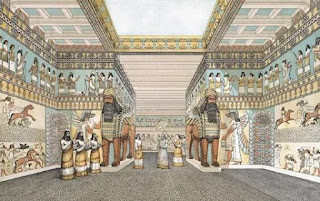The Library of Ashurbanipal, also known as the Royal Library of Nineveh, was a vast collection of cuneiform tablets and writings assembled during the reign of King Ashurbanipal (668–627 BC) of the Neo-Assyrian Empire. This ancient library is considered one of the most significant archaeological discoveries in the study of Mesopotamian history and culture. Here's more about the Library of Ashurbanipal:
Historical Context:
- The Neo-Assyrian Empire was a powerful empire that ruled over a vast territory in the ancient Near East, including parts of present-day Iraq, Syria, and Iran.
- King Ashurbanipal was an influential ruler known for his military conquests and his patronage of scholarship and learning.
Collection and Contents:
- The library contained a vast collection of cuneiform tablets, which were made from clay and inscribed with wedge-shaped characters. These tablets covered a wide range of topics, including literature, religious texts, scientific treatises, administrative records, legal codes, and more.
- Some tablets contained copies of earlier works from the Sumerian and Akkadian civilizations, preserving valuable knowledge from earlier periods.
Location:
- The library was located in the city of Nineveh, the capital of the Neo-Assyrian Empire. Nineveh was situated near the Tigris River in what is now modern-day Mosul, Iraq.
Scholarly Activities:
- King Ashurbanipal was a patron of learning and scholarship. He actively sponsored the collection and transcription of texts from various regions of the empire.
- Scholars and scribes worked to gather, translate, and copy texts into the Akkadian language, ensuring the preservation of a wide range of knowledge.
Cuneiform Writing and Language:
- Cuneiform was a writing system used by the ancient civilizations of Mesopotamia. The library's texts were written in cuneiform, which was imprinted onto clay tablets using reed styluses.
- The Akkadian language was the primary language of the library's texts, although some tablets were written in other languages, such as Sumerian.
Rediscovery and Archaeological Excavations:
- The library was lost to history after the fall of the Neo-Assyrian Empire. Its existence was known through ancient inscriptions and historical accounts.
- The library was rediscovered during archaeological excavations in the mid-19th century by British archaeologist Sir Austen Henry Layard and his successors. Many of the tablets were found in the ruins of the palace of Ashurbanipal in Nineveh.
Legacy and Significance:
- The Library of Ashurbanipal provides valuable insights into the culture, religion, literature, science, and daily life of ancient Mesopotamia.
- The texts preserved in the library have contributed to our understanding of historical events, including the interaction between Assyrians and other civilizations.
The Library of Ashurbanipal remains a critical source for studying the ancient world, offering a glimpse into the intellectual pursuits and achievements of one of history's great empires. Many of the tablets from the library are now housed in museums around the world, including the British Museum in London.



Comments
Post a Comment